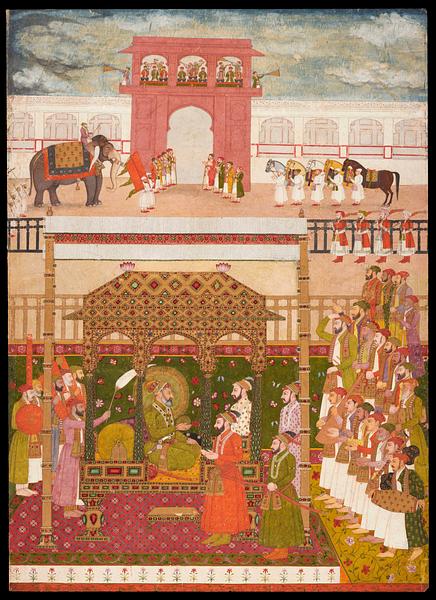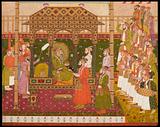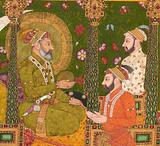The last of the significant great Mughals, Aurangzeb, died in 1707. After a brief struggle among his relatives (see also
4/1980 and
13/2015), his second-oldest son, Muhammad Muazzam, assumed power under the name of Bahadur Shah (1707-1712).
The c. 63-year-old ruler is seated in isolation on a magnificent, bejeweled throne under a pearl-embroidered canopy with a globe in his right hand and is the only one whose head is highlighted by a halo.
Bahadur Shah is surrounded by a wealth of courtiers, servants, and musicians. The most prominent figures are his four sons, who are depicted as being a bit smaller than their father but larger than the other members of the court. There is consequently no doubt about the power structure.
It is unclear whether this depicts a specific event, but the ceremonies under the Great Mughals included a
darbar or
durbar on various occasions where a council could be held during which prominent men could be received and honored, people outside the court’s narrow circle could be presented, and perhaps most important of all, where everyone of importance could see that the ruler did indeed rule. (See also
20/1979.)
The scene takes place in the courtyard of one of the Great Mughal’s forts, but despite the gatehouse, there are no details that clearly show which one. The way in which the characters are depicted is also very formal and does not have the naturalism and individualization that characterized art under the ruler’s great grandfather Jahangir (1605-1627) and grandfather Shah Jahan (1628-1657). The latter’s
Padshahnama does have many scenes with related themes,
[1] but interest in realistic depictions and visual art disappeared as a whole from court art under the strictly orthodox Muslim Aurangzeb (1658-1707).
The miniature has been attributed to Bhavanidas, who was the leading artist at the Mughal court in Delhi during this period. He helped revitalize Mughal painting and later had a major influence on local art in Kishangarh, where he lived from 1719.
[2]The painting previously belonged to Warren Hastings (1732-1818), who was the first British Governor- General in India.



